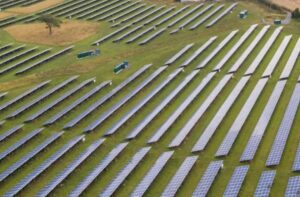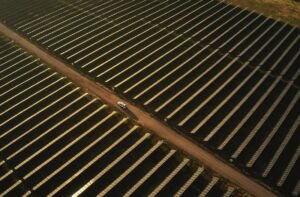IT guru Simon Hackett must be the number 1 fan of Tesla electric vehicles in Australia. He took delivery of the first Tesla Roadster in Australia in 2009, and now he drives the last Roadster delivered here.
He also took delivery of the first two long range, high performance Tesla Model S electric vehicles in Australia last year, and has two more on the way already as upgrades. One is the latest Tesla model P85D with its “almost frightening” acceleration, and he also has an order for one of the first Model X, the electric SUV with winged doors.
“I love these things,” Hackett says in an interview with RenewEconomy. “The model S has changed the conversation about EVs. ” So much so, he says, that electric motors will soon become a routine consideration when buying a car. Do consumers want petrol, diesel or electric?
And Hackett believes that Tesla’s intervention in the battery storage market will have a similar impact. Within 10 years, he predicts, battery storage will be as commonplace in homes and businesses as broadband, which barely existed in 2000 but was widespread just a decade later in 2010.
But in this market, Hackett will not be the number 1 consumer of Tesla, but potentially the number 1 competitor, as the newly installed chairman (and largest shareholder) of Australian battery storage company Redflow.
“We are at the start of that 10 year cycle,” says Hackett. “I reckon that within 10 years, energy storage will become a routine design choice. It’s not an experiment. We are at the cusp of that becoming routine and normal and incredibly effective.”

Hackett took over as chairman of Redflow last week, and believes that Redflow has the technology with its “flow batteries” to compete against Tesla, and the myriad other developers of lithium-ion batteries.
“This is the company in Australia that is doing serious innovation in batteries,” Hackett says of Redflow. And he has put his money where his mouth is, and vice-versa.
His first big task is to use his IT skills, and those of his private company Base64, to write the smart software that will allow a plug and play version of Redflow’s zinc bromine “flow” batteries that is simple to use.
As Hackett explains it, the physics and the chemistry of the Redflow flow battery has largely been mastered, although continuing price and performance improvements. The focus is now on IT and software.
“The future of the energy storage and handling sector is increasingly about the deployment of smart and dynamic control mechanisms to manage energy flows,” he says. “Here’s the analogy: Redflow makes hard drives, and what I am designing here is a high availability file server for them to be put into. What you will get early next year is battery system that can be easily configured and also easily scaled up later, and managed with a web browser.”
A year ago, Redflow was barely considering the consumer market for battery storage, at least in Australia. But the rapidly falling feed-in tariffs, rising electricity bills and Tesla’s dramatic intervention, has created a huge amount of interest in the technology.
“Tesla put fire under idea and with the feed-in tariffs going away, batteries are getting cheap enough for consumers to take matters into their own hands,” Hackett says.
“People started ringing Redflow and saying ‘you have got a fabulous looking battery technology – can I plug it into my house’? So I am driving the IT design and architecture to make that happen.”
Redflow announced last week that recent continued successful test results, and progress in the manufacturing process have allowed Redflow to extend its battery warranty and lower the unit price so that the effective lifetime cost per delivered kilowatt-hour has fallen by almost 50 per cent.
Hackett says the cost may come down even more. That’s because the flow battery loves doing what other batteries cannot do – it thrives on full discharge and charge.
So much so, that the latest tests suggest that the battery will live longer than previously though. The battery will have warranty for 3,000 full 10 kilowatt-hour energy delivery cycles. Redflow believes they will be good for at least 4,000, because testing of the latest electrode stack iteration has returned excellent results. “We don’t yet know quite how long our latest electrode stack will last – we will need to do a lot more long term testing – but we’re quite sure that its a lot better than our preceding versions.”
That’s important because the key to the cost of battery storage is in its life cycle, not just the capital cost. It’s just like electrical appliances and solar panels: there are cheaper options but they might not last as long.
At the moment – over a 10 year period – Redflow estimates the cost of production at around US 20c/kWh. Even with the exchange rate taken into account, and given that solar electricity probably costs between 10-13c/Wh, that is putting the technology in the ball-park, where it starts to compete with the grid.
“If we get another halving of that number over time, then everything gets rather fascinating,” Hackett says. That, he notes, is where the price drops between the differential between peak and off peak pricing, and battery storage becomes no brainer in a country with high electricity costs, mostly driven by the high cost of the grid.
In anticipation of this, and in response to more rises in electricity prices, Hackett says the market is “going mad”.
“The interest level is enormous. It feels like exactly what I was doing in internet terms 15 years ago. It is early days and everything costs more than people would like it to, but volume increases will surely drive prices down.
“It’s like the early days of solar panels, when only true believers could afford it. But that’s cool, they will tell their friends, and then when their friends get their (feed in) tariffs removed, they will add energy storage as the logical response.”
That’s when the consumers will decide to keep the electricity they generate from their solar panels and use it at night time. Morgan Stanley estimates that around 230,000 solar households in Victoria, South Australia and Victoria will come off premium feed in tariffs by the end of 2016.
Meanwhile, feed in tariffs for new installations continue to be cut, and fixed charges will continue to rise.
Hackett’s own house in Adelaide is “off grid capable. Which is to say that it has 10kW of solar panels and 20kWh of battery storage (currently lead-acid, and soon to be replaced with Redflow batteries)”.
But as soon as the tariff changes and, say, fixed charges are jacked up high enough, he will reach the point where it becomes sensible to simple go off-grid. And he expects many others to follow.
 He will do the same with his office complex in Adelaide. The building will soon take delivery of a 660kWh array of Redflow batteries. Hackett says that is enough energy to run the office building for several days.
He will do the same with his office complex in Adelaide. The building will soon take delivery of a 660kWh array of Redflow batteries. Hackett says that is enough energy to run the office building for several days.
In the first instance, he is going to fill the batteries up on off peak and run them during peak demand, to test the economics. The next option is to take the building off-grid, although that will likely need some 70kW of rooftop solar to be installed over the parking area.
“One reaction to electricity companies taking (feed in tariffs) away is to just say ‘I accept’. Taking tariffs away is a core driver for the future.”
Among the new innovations being introduced by Hackett is a decision to have Flextronics manufacture the battery electrode as well as the rest of the product.
He says this wil create the cleanest path to high volume manufacture, and will remove any risk that its Brisbane site will become a production-rate bottleneck in the future. And it will allow the Brisbane site to focus on battery R&D.
 Hackett describes zinc bromine flow batteries as an “inside out” battery”– because the fluids live outside the battery rather than inside. It doesn’t mind whether it it totally full or totally empty; it can run in temperatures from 5c to 45C.
Hackett describes zinc bromine flow batteries as an “inside out” battery”– because the fluids live outside the battery rather than inside. It doesn’t mind whether it it totally full or totally empty; it can run in temperatures from 5c to 45C.
“You don’t have to be nice to it. The battery electrode is being constantly refreshed by the electrolyte tanks. For the electrode stack, its like having packet of Tim Tams that never runs out.”
It can be turned off in any charge state, and can spring back to life within a few seconds when needed. At the base level you get a battery that lasts several times longer than lead acid. And while lithium ion is a “sprinter”, flow batteries are “marathon runners”.








